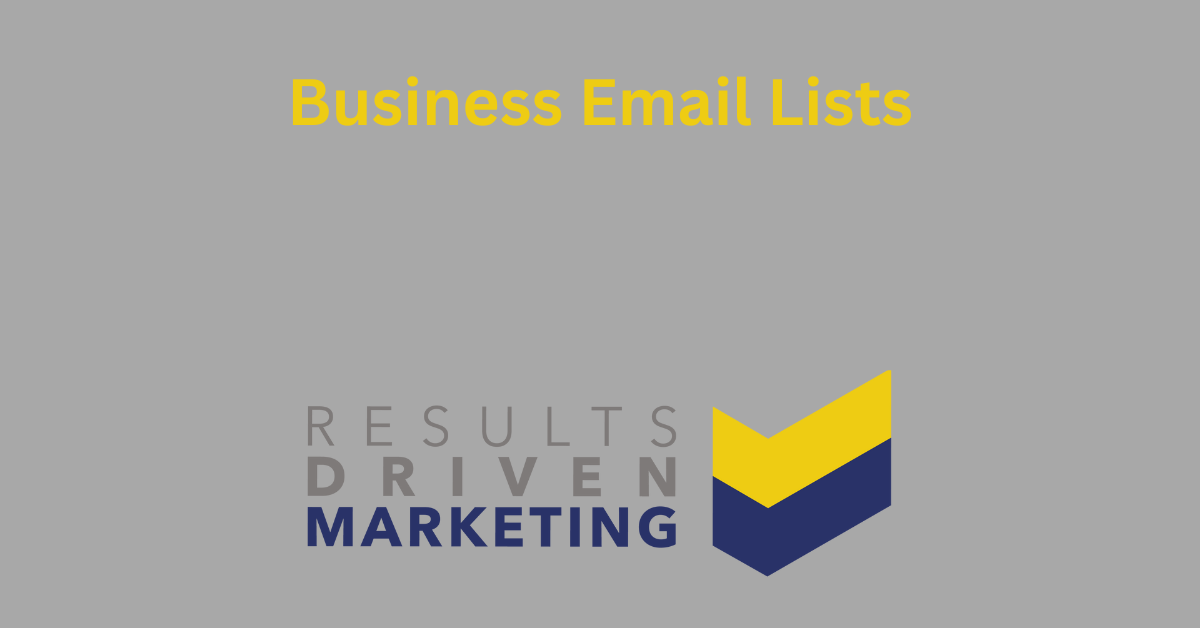
Business Email Lists
Business Email Lists are a collection of contact information – including names, addresses, phone numbers, email addresses and other relevant information – of businesses and/or individuals who may potentially be interested in a company’s products or services.
Mailing lists can be used for campaigns to generate leads, customer communications, sales distribution and more.
For information on how we can supply you with high-quality business email lists, contact us to discuss your specific criteria.
What are Business Email Lists used for?
Business Email Lists are used for direct mail campaigns, promotional mailings, and targeted marketing.
These lists are typically compiled from different sources to create an up-to-date list of customers, prospects, and subscribers.
Business mailing lists are often used to send newsletters, product updates, special offers, and other related communications.
Why are they so important?
Business Email Lists are important because they provide a way to quickly target potential customers with specific messages that are likely to be of interest to them.
Business Email Lists allow businesses to quickly and easily target a specific and relevant audience to ensure higher conversion rates and increased engagement.
These lists can be easily customised to the target market and are the most cost-effective means of marketing.
Additionally, with business mailing lists, companies can reach a larger and more engaged customer base, help to build relationships with customers, generate leads, and create brand awareness.
What are the main benefits of Business Email Lists?
Access to Highly Targeted Contact Information
Business Email Lists can help businesses segment target audiences quickly and accurately.
This helps ensure that the right people and companies get the right messages.
Low Cost Marketing
Bulk mailing lists are one of the most cost effective marketing tools available to businesses.
By having access to an accurate and up-to-date list of contacts, companies can save time, money, and resources.
Increased Brand Recognition
Sending direct mailers to targeted audiences can help build brand recognition.
Brand messaging can be easier to understand through direct mail and help create recognition among potential customers.
Increased Connections with Potential Customers
Business mailing lists can help companies make connections with potential clients.
By connecting with the right people, businesses can create meaningful relationships with their target audiences.
Opportunity to Increase Sales
With the right mailing list, businesses can increase sales opportunities.
By targeting the right people, businesses can identify potential customers and create a tailored marketing message to reach them.
Improved Quality of Leads
Quality leads create better sales.
By utilising mailing lists, businesses can access information to segment the right contacts and create highly targeted campaigns.
This will help ensure that the leads generated are of high quality.
What are the different types of Business Email Lists?
Industry Specific Business Email Lists
These lists include detailed information on businesses within a specific industry, including information on location, size and contact details.
Targeted Business Email Lists
These lists focus on specific criteria, such as geography, demographics, and size, so that you can focus on the customers that you’re interested in marketing to.
Executive Lists
These are high-end business lists focused on C-level executives and senior decision makers within an organisation.
Compiled Business Email Lists
These are lists compiled from publicly available sources that offer basic contact information, such as name and email address.
Specialty Business Lists
These lists are tailored to include businesses that fit within the parameters of the particular industry you’re interested in.
How to build Business Email Lists?
Use opt-in forms on your website or landing pages
Include an opt-in box on company invoices or receipts
Collect email addresses at trade shows, conferences, or other events
Leverage social media
Utilise any partnerships or connections you have
Offer incentives for signing up
Buying a third-party list
There is so much to cover that I won’t go into full detail now, but I will cover the absolute basics.
Make sure you have a clear data brief
It is essential to understand exactly who your target audience is and to develop an ICP.
You can do this on your own but may want to consider working alongside a supplier like Results Driven Marketing at this point to help you ask the questions of your customer database that you need to.
These questions might be along the lines of:
Where are your top customers located geographically?
What sectors do they operate in?
How many staff do they have?
How much do they turnover?
Who within those organisations do you look to target?
Make sure your potential supplier provides you with samples and breakdowns
Getting this information is really important to make sure that your supplier fully understands your brief and is aware of exactly what your ICP is.
At Results Driven Marketing, we supply both breakdowns and then samples.
This makes sure clients are comfortable that we clearly understand and will be delivering a database that will work for you.
Check the licensing terms
Post-GDPR, most suppliers offer licensed products. The most common is a 12-month multi-use licence.
This might sound like you can use it as much as you like over a 12-month period but may actually be limited to 12 email sends only.
We find that 12 emails sends over a 12-month period are adequate, but it is important that you understand all the usage rules before you dive in.
Check supplier accuracy guarantees
Is the supplier’s database guaranteed accurate? What if you get it and all the emails bounce?
Ask your supplier what guarantees they have in place should things not work out as you would expect.
All files released by us are guaranteed accurate to industry high standards and are GDPR compliant.
We guarantee:
- 98% postal address accuracy
- 90% telephone number and contact name accuracy
- 90% email address accuracy
Should we fall below and of the above benchmarks, we are obliged to provide like-for-like replacements or a pro-rata refund.
Visit us here for more information.
How to segment a Business Email Lists?
Collect and analyse customer data
Create customer segments
Identify your target audience
Create targeted campaigns
How to maintain Business Email Lists?
Keep it Up-to-Date
Make sure your business mailing list is always up-to-date.
Regularly review and delete outdated email addresses, add new contacts, and update missing or incorrect customer information.
Reach Out Regularly
Make sure to reach out to your contacts regularly with professional messages and offers.
If you’re not contacting your list regularly, you’re likely not getting the return you’d expect.
Segment Contacts
Segment your contacts into different lists so you can better target your messages.
You can also create custom audiences based on customer behaviours, interests, or demographics.
Utilise Automation
Use automated processes and triggered emails to simplify the process of engaging contacts.
You can use automation to save time and ensure that no customer goes unnoticed.
Analyse Your Data
Use analytics to get valuable insights from your business mailing list.
Analyse your contact data to measure the success of your campaigns, uncover trends and opportunities, and understand your customers better.
How to cleanse your Business Email Lists?
Email marketing to Business Email Lists
Email marketing has become one of the most effective and efficient ways for businesses to promote their products and services to potential customers.
The UK has a large number of businesses which can greatly benefit from email marketing services.
In this article, we will discuss the benefits of email marketing products and services to UK business lists.
1. Cost-effective:
Email marketing is highly cost-effective when compared to other marketing channels. With email marketing services, businesses can reach out to a large number of potential customers at a minimal cost. UK businesses can save a significant amount of money by leveraging email marketing services to promote their business.
2. Targeted marketing:
Email marketing allows businesses to segment their email list by demographics, interests, behaviour, and location.
With targeted marketing, businesses can ensure they are marketing to the right audience.
This targeted marketing also means more effective messaging, as the content can be highly personalised to the specific target audience.
3. High conversion rates:
Studies show that email marketing has higher conversion rates than other means of marketing, such as social media or search engines.
UK businesses can use email marketing to get higher conversion rates for their products and services.
Emails can be designed to entice potential customers to take action by providing customised deals, offers, or calls-to-action.
4. Measurable and trackable:
Email marketing provides businesses with the ability to track their campaigns and measure results.
UK businesses can analyse their email campaigns to see which messages, design elements, or calls-to-action resonate the most with customers.
This allows businesses to optimise their future email campaigns for higher performance.
5. Increased brand awareness:
Email marketing leads to increased brand awareness for UK businesses.
By regularly sending emails to their customers, businesses can establish a strong brand presence in the minds of their target audience.
This ongoing interaction with customers through email campaigns can help to build brand loyalty and influence purchase decisions.
In conclusion, email marketing products and services provide UK businesses with an efficient, cost-effective, and measurable way to reach out to potential customers.
With targeted marketing, high conversion rates, and increased brand awareness, businesses can grow and succeed by using email marketing as an effective marketing channel.
Best practices for email marketing to business mailing lists
Make sure your email copy is succinct, relevant and engaging
Utilise personalisation
You can use customer or demographic data to tailor emails to relevant subscribers.
Leverage segmentation
You should segment your database into different categories and target each group with emails that are tailored to their interests.
Include a call to action
Let subscribers know what you want them to do in order to take the next step.
Utilise A/B testing
Experiment with different variables in your emails to maximise their performance.
Monitor your metrics
Track various metrics from your emails (such as open rate, click-through rate, and conversion rate) to make sure your messages are effective.
How to A/B split test email marketing campaign to Business Email Lists
In the digital age, email marketing continues to be a crucial strategy for businesses to engage with their target audience.
However, with the increasing competitiveness of the digital landscape, it is essential to ensure that your email campaigns stand out and yield the desired results.
A/B split testing emerges as a powerful technique to optimise your email marketing efforts and enhance conversions.
In this article, we explore the benefits of A/B split testing for business email lists and provide valuable insights to help you make the most of this strategy.
Understanding A/B Split Testing:
A/B split testing, also known as A/B testing or bucket testing, is a method where two or more versions of an email campaign are created and sent to different segments of your business email list. By measuring the performance of each variant, you can identify which elements generate the best response rates, conversions, and engagement metrics.
Selecting Test Variables:
To conduct an effective A/B split test, it is crucial to focus on specific variables within your email campaign. Some common elements worth testing include:
1. Subject Lines:
The subject line is the first impression you make on your recipients. Test different subject lines to determine which ones result in higher open rates.
2. Sender Name:
The name or brand associated with the email can impact open rates. Experiment with variations of sender names to find the one that garners the most trust and credibility.
3. Email Design:
Test different layouts, color schemes, and typography to evaluate the impact on click-through rates and overall engagement.
4. Call-to-Action (CTA):
Experiment with various CTAs, such as button styles, text placement, and language, to assess their effectiveness in driving conversions.
5. Personalisation:
Test personalised email content, including recipient names or tailored recommendations, to gauge its impact on engagement and click-through rates.
Implementing the A/B Split Test:
To ensure accurate and reliable results, it is important to follow these guidelines when conducting an A/B split test for your business email campaigns:
1. Define Clear Objectives:
Clearly outline the goals of your test, such as increasing open rates, click-through rates, or conversions. This will help you focus your efforts and measure success accurately.
2. Segment Your Email List:
Divide your business email list into random, representative segments to ensure that each variant of your campaign reaches an unbiased audience.
3. Test One Variable at a Time:
To isolate the impact of each variable, test only one element at a time. This allows you to attribute changes in performance to specific modifications.
4. Split Traffic Equally:
Ensure an equal distribution of your email traffic between the test variants. This helps eliminate biases and provides statistically significant results.
5. Measure and Analyse Results:
Monitor key metrics such as open rates, click-through rates, conversions, and revenue generated. Analyse the data to identify the most successful variant and draw actionable insights.
Iterate and Optimize:
A/B split testing is an iterative process.
\Once you have identified the winning variant, implement the learnings into your future email campaigns. Continuously test new variables and strategies to refine your approach and maximize the effectiveness of your email marketing efforts.
Conclusion:
A/B split testing is an invaluable tool for businesses looking to optimise their email marketing campaigns.
By experimenting with different variables and analysing the results, you can uncover valuable insights that drive higher engagement, conversions, and ultimately, business success.
Remember to focus on one variable at a time, measure results accurately, and iterate based on the outcomes.
Embrace the power of A/B split testing to unlock the true potential of your business email lists and stay ahead of the competition in the ever-evolving digital landscape.
Summary
The use of business mailing lists has seen a dramatic increase as companies look for new methods to reach potential customers.
These mailing lists are lists of names and contact information for people or companies that may be interested in a certain product or service.
The purpose of this list is for businesses to be able to contact their target audience and make their marketing campaign more targeted and effective.
Mailing lists can be segmented into various categories based on different demographics, such as age, gender, occupation, location, income, and interests.
Businesses may also use primary and secondary research to create more precise, targeted mailing lists.
When choosing a mailing list, marketers should consider the list’s relevancy, accuracy, and freshness.
Relevancy is determined by how closely the list matches the product or service being marketed.
Accuracy is important because if the list contains incorrect or outdated information, a business’s marketing efforts will be in vain.
Lastly, freshness is important because outdated information may be less accurate and lead to fewer conversions.
Businesses can also use a combination of email, direct mail, and telemarketing to reach their target audience.
Although these channels may be more expensive than simply using mailing lists, they have the potential to reach larger and more targeted audiences.
Additionally, businesses may need to combine these methods to maximise their reach and obtain better results.
Overall, business mailing lists can be a powerful tool for businesses looking to target their desired audience.
By utilising mailing lists, businesses can rest assured that their marketing efforts are more focused, accurate, and effective.
For more information about Results Driven Marketing and our third party mailing lists, feel free to contact us here.





